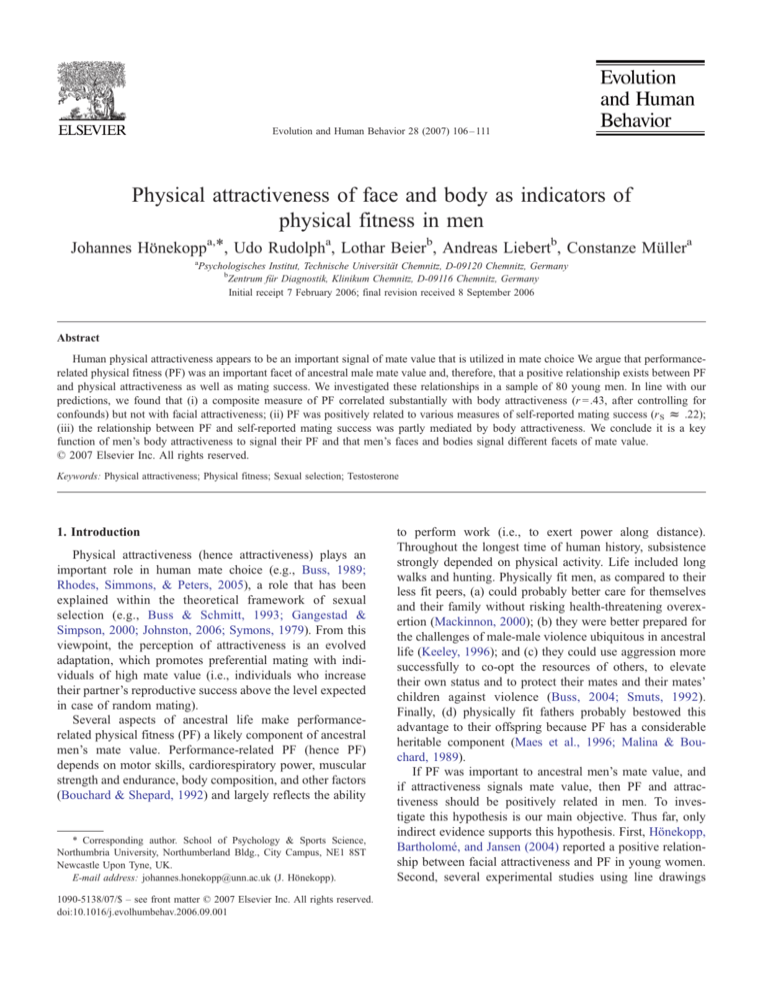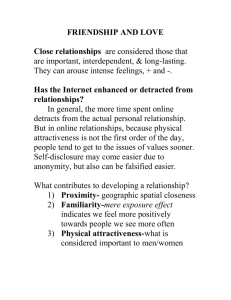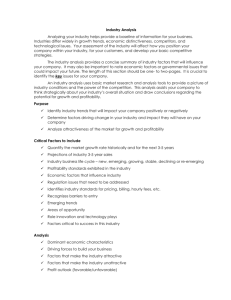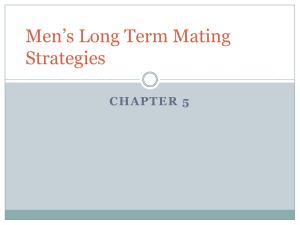
Evolution and Human Behavior 28 (2007) 106 – 111
Physical attractiveness of face and body as indicators of
physical fitness in men
Johannes Hfnekoppa,4, Udo Rudolpha, Lothar Beierb, Andreas Liebertb, Constanze Mqllera
a
Psychologisches Institut, Technische Universität Chemnitz, D-09120 Chemnitz, Germany
b
Zentrum für Diagnostik, Klinikum Chemnitz, D-09116 Chemnitz, Germany
Initial receipt 7 February 2006; final revision received 8 September 2006
Abstract
Human physical attractiveness appears to be an important signal of mate value that is utilized in mate choice We argue that performancerelated physical fitness (PF) was an important facet of ancestral male mate value and, therefore, that a positive relationship exists between PF
and physical attractiveness as well as mating success. We investigated these relationships in a sample of 80 young men. In line with our
predictions, we found that (i) a composite measure of PF correlated substantially with body attractiveness (r = .43, after controlling for
confounds) but not with facial attractiveness; (ii) PF was positively related to various measures of self-reported mating success (r S 6 .22);
(iii) the relationship between PF and self-reported mating success was partly mediated by body attractiveness. We conclude it is a key
function of men’s body attractiveness to signal their PF and that men’s faces and bodies signal different facets of mate value.
D 2007 Elsevier Inc. All rights reserved.
Keywords: Physical attractiveness; Physical fitness; Sexual selection; Testosterone
1. Introduction
Physical attractiveness (hence attractiveness) plays an
important role in human mate choice (e.g., Buss, 1989;
Rhodes, Simmons, & Peters, 2005), a role that has been
explained within the theoretical framework of sexual
selection (e.g., Buss & Schmitt, 1993; Gangestad &
Simpson, 2000; Johnston, 2006; Symons, 1979). From this
viewpoint, the perception of attractiveness is an evolved
adaptation, which promotes preferential mating with individuals of high mate value (i.e., individuals who increase
their partner’s reproductive success above the level expected
in case of random mating).
Several aspects of ancestral life make performancerelated physical fitness (PF) a likely component of ancestral
men’s mate value. Performance-related PF (hence PF)
depends on motor skills, cardiorespiratory power, muscular
strength and endurance, body composition, and other factors
(Bouchard & Shepard, 1992) and largely reflects the ability
4 Corresponding author. School of Psychology & Sports Science,
Northumbria University, Northumberland Bldg., City Campus, NE1 8ST
Newcastle Upon Tyne, UK.
E-mail address: johannes.honekopp@unn.ac.uk (J. Hfnekopp).
1090-5138/07/$ – see front matter D 2007 Elsevier Inc. All rights reserved.
doi:10.1016/j.evolhumbehav.2006.09.001
to perform work (i.e., to exert power along distance).
Throughout the longest time of human history, subsistence
strongly depended on physical activity. Life included long
walks and hunting. Physically fit men, as compared to their
less fit peers, (a) could probably better care for themselves
and their family without risking health-threatening overexertion (Mackinnon, 2000); (b) they were better prepared for
the challenges of male-male violence ubiquitous in ancestral
life (Keeley, 1996); and (c) they could use aggression more
successfully to co-opt the resources of others, to elevate
their own status and to protect their mates and their mates’
children against violence (Buss, 2004; Smuts, 1992).
Finally, (d) physically fit fathers probably bestowed this
advantage to their offspring because PF has a considerable
heritable component (Maes et al., 1996; Malina & Bouchard, 1989).
If PF was important to ancestral men’s mate value, and
if attractiveness signals mate value, then PF and attractiveness should be positively related in men. To investigate this hypothesis is our main objective. Thus far, only
indirect evidence supports this hypothesis. First, Hönekopp,
Bartholomé, and Jansen (2004) reported a positive relationship between facial attractiveness and PF in young women.
Second, several experimental studies using line drawings
J. Hönekopp et al. / Evolution and Human Behavior 28 (2007) 106 – 111
have found female preferences for male figures with a
medium body mass index and a pronounced upper body vshape, a likely indication of a lean, muscular physique
and, thus, PF (Dixson, Halliwell, East, Wignarajah, &
Anderson, 2003; Furnham & Baguma 1994; Horvath, 1981;
Lavrakas, 1975; but see Gitter, Lomranz, & Saxe, 1982 for
conflicting results). Moreover, two correlational studies
using more realistic stimuli supported these experimental
results: Fan, Dai, Liu, and Wu (2005), using 3D wire frame
film clips, and Maisey, Vale, Cornelissen, and Tovée
(1999), using front view photographs, found male bodies
with low body mass index, broad chests and small waists to
be attractive for women. Third, women positively respond
to faces rated high for masculinity (Cunningham, Barbee,
& Pike, 1990; Koehler, Simmons, Rhodes, & Peters, 2004;
Rhodes, Chan, Zebrowitz, & Simmons, 2003). Facial
masculinity may indicate high testosterone levels (e.g.,
Johnston, 2006; Penton-Voak & Chen, 2004), and testosterone promotes muscle growth (Bhasin, Woodhouse, &
Storer, 2001). Therefore, women’s preference for masculine
faces may indicate a preference for muscular and, thus,
physically fit men.
A potential relationship between attractiveness and PF in
men has not been investigated yet. Our objective is to close
this gap. We also analyze testosterone, rated masculinity,
upper body v-shape, body mass index, and height as
potential mediators for the hypothesized relationship between men’s attractiveness and their PF. Given that
attractiveness has the function to promote mating with
individuals of high mate value (see above), we also expect
that PF and mating success are positively correlated in men
and that attractiveness mediates this relationship.
2. Methods
2.1. Participants
One hundred two healthy Caucasian men from Chemnitz
and vicinity participated in this study after giving their
informed consent. Participants were recruited via an
advertisement in a local newspaper and by leaflets
distributed on the University Campus. All participants
received a payment of 25o. Relationships of 2nd- to 4thdigit ratio with PF and number of sex partners in this sample
have been previously reported (Hönekopp, Manning, &
Müller, 2006; Hönekopp, Voracek, & Manning, 2006).
Here, we report the data of all 80 men who agreed to be
photographed unclothed (see below). Participants completed
a questionnaire surveying age, height, weight, sexual
orientation, and potential confounds of PF (smoking,
alcohol consumption, drug use, and amount of exercising).
Descriptive statistics are given in Table 1. Due to men’s low
minimum parental investment, their mating success importantly hinges on their number of sex partners (Buss &
Schmitt, 1993; Trivers, 1972). Therefore, we used the
following variables to assess men’s self-reported mating
107
Table 1
Descriptive statistics of sample
MeanFSD
Age (years)
Height (cm)
Weight (kg)
Body mass index (kg/m2)
Upper body v-shape
Testosterone (nmol/l)
SHBG (nmol/l)
Free androgen index
PF score
Exercising (min/week)
Smoking (cigarettes/d)
Drug use (% users)
Number of sex partnersa
Number of extrapair copulationsa
Age at first sexa,b
a
b
22.4F1.3
182F7
75.9F9.9
23.0F2.3
1.38F.09
17.9F5.2
24.7F8.7
.83F.41
175F20
337F273
2.5F4.9
18
4.6F4.7
.6F1.0
17.7F2.2
Seventy-seven exclusively heterosexual participants.
Actual age was used for five inexperienced participants.
success: lifetime number of sex partners, age at first
intercourse, and number of times they had been an extrapair copulation partner (i.e., how often another person
cheated on their partner). We relied on self-reported height
and weight because these have turned out to be highly
accurate (Bowman & DeLucia, 1992; Imrhan, Imrhan, &
Hart, 1996).
2.2. Assessment of PF
Participants’ PF was assessed using the Haro fitness test
(Haag 1981; see also Hönekopp et al., 2004). This gymbased test consists of six heterogeneous exercises, which
require (i) running and crawling beneath an obstacle, (ii) sit
ups, (iii) repeated jumps over a hurdle, (iv) push ups, (v)
running and picking up items from the floor, and (vi)
throwing a ball repeatedly against the wall while lying on
the belly. All exercises were scored according to the test
rules. Participants were tested by two male experimenters
blind to the hypotheses.
2.3. Ratings of attractiveness and masculinity
For later assessment of attractiveness, three digital color
photographs (face, body front, and body back) were taken
from each participant. Pictures were taken from a standard
distance (faces: 1.5 m; bodies: 3 m) at a resolution of
10241344 pixels. For the face photographs, sitters wore a
bathing cap (to reduce the influence of hair style), showed a
neutral expression, and faced the camera frontally. For the
body photographs, 80 men agreed to pose unclothed. A
brick wall served as background for the body photographs.
For the face photographs, backgrounds varied slightly and
were later blurred. All photographs were cropped and
standardized to the same height of 520 pixels. Faces were
made unrecognizable on all front body photographs.
Twenty-seven women (age 25.6F6.6 years) rated all 240
individual photographs for attractiveness (1 =bnot at all
108
J. Hönekopp et al. / Evolution and Human Behavior 28 (2007) 106 – 111
attractive,Q 7 =bvery attractiveQ). Fourteen other women (age
25.1F2.9 years) did the same for masculinity (1= bnot at all
masculine,Q 7 = bvery masculineQ). In agreement with previous research, we did not provide a definition of attractiveness or masculinity (e.g., Penton-Voak & Chen, 2004;
Rhodes et al., 2003). Raters were approached at university
campuses in Dresden and Leipzig (Germany) and received
3o for participation. All raters reported to feel sexually
attracted by men. Ratings were performed on notebook
computers. In each group, half of the raters rated all face
pictures first and then all body pictures, whereas this order
was reversed for the other raters. The order of pictures
within each block was individually randomized for each
rater. We relied on ratings instead of measurements of facial
masculinity because the former appear to be more valid
(Penton-Voak & Chen, 2004; Rhodes et al., 2003).
2.4. Assessment of upper body v-shape
Two raters blind to all other data measured upper body vshape (distance between armpits divided by narrowest waist
diameter) from back photographs using Morph Man 2.01
software, which allows for storing the coordinates of
specified points. Both measurements correlated highly
(r = .97, p b .001). Subsequent analyses are based on the
average of both measurements.
2.5. Hormone measurements
On the day of testing, participants provided blood
samples between 8:00 and 10:00 am. The obtained serum
was aliquoted and stored at 208C. Total testosterone and
SHBG (sex hormone-binding globuline) serum concentrations were analyzed by radioimmunoassay at the Klinikum
Chemnitz. The kits RIA ACTIVE TESTOSTERONE and
RIA SHBG (Diagnostic System Laboratories, Webster, TX,
USA) were used, following the manufacturer’s protocol.
The kits show interassay variabilities of b 10% and b 5%,
respectively. All control values were within the range
specified by the manufacturer. We based our analyses of
testosterone on a free androgen index, which was computed
as total testosterone/SHBG. Free androgen index highly
correlates with free testosterone (Nanjee & Wheeler 1985).
3. Results
A principal components analysis of the six Haro exercise
scores suggested a one-factor solution. The factor explained
54% of the variance, and all six exercise scores loaded high
on it (see Table 2 for intercorrelations and factor loadings).
This justified summing all scores into a single measure of
PF, henceforth, PF. Cronbach’s alpha for PF was .80.
Block order of ratings (faces first vs. bodies first) proved
to be inconsequential. We thus analyzed all data together.
All average ratings of faces and bodies proved reliable
(Cronbach’s alpha for attractiveness were: face = .89, body
front = .93, body back = .96; masculinity: face = .85, body
front = .93, body back = .91). If not noted otherwise, all
Table 2
Correlations between fitness subtests and their loadings on the first factor
Test
Test
Test
Test
Test
Test
1
2
3
4
5
6
Test 2
Test 3
Test 4
Test 5
Test 6
Loading
.44***
.47***
.39***
.53***
.30**
.46***
.53***
.26*
.61***
.44***
.53***
.34**
.54***
.41***
.44***
.80
.59
.80
.72
.76
.74
*p V .05; **p V .01; ***p V .001, respectively.
following analyses involving attractiveness or masculinity
pertain to values averaged across raters. Attractiveness
ratings took little time. Median response times were 3.3 s
(faces), 3.6 s (front), and 3.3 s (back) for each picture. Facial
attractiveness correlated moderately with attractiveness of
front (r =.34, p = .002) and back (r =.29, p = .009). Attractiveness of front and back correlated highly (r = .83,
p b.001). For the sake of reporting economy, we use a
single measure of body attractiveness (front attractiveness/
2+back attractiveness/2) and body masculinity (masculinity
front/2+masculinity back/2) in all subsequent analyses.
Body attractiveness moderately correlated with facial
attractiveness (r =.33, p = .003).
In order to identify potential effects of modern lifestyle
variables on PF, we entered reported exercising time,
smoking, alcohol consumption, dummy-coded drug use,
and body mass index into a stepwise regression analysis to
predict PF. Exercising (b = .45, T = 4.4; p b .001) and
smoking (b = .24, T = 2.4; p = .018) proved significant.
Consequently, we report all correlations between attractiveness and PF (a) as first-order correlations and (b) to exclude
potential artefacts, controlling for exercising and smoking
(enclosed in brackets).
In line with our main hypothesis, we found a substantial
correlation between PF and body attractiveness (r = .48[.43],
p b.001[ b .001]), depicted in Fig. 1. In contrast, facial
attractiveness did not correlate with PF (r = .01[ .04],
p =.92[.75]).
To understand which factors contribute to body attractiveness, we entered age, height, body mass index, free
androgen index, rated body masculinity, and upper body vshape into a stepwise regression analysis to predict body
attractiveness. Rated masculinity (b = .78, T = 12.0; p b .001)
and body mass index (b = .36, T = 5.5; P b.001) proved
significant. To test whether these variables might mediate
the relationship between PF and body attractiveness, we
also entered them into a stepwise regression analysis to
predict PF. Only rated masculinity proved to be significant
(b = .58, T =6.1; p b.001). As rated masculinity correlated
highly with body attractiveness and with fitness, it is likely
that masculinity mediated the relationship between the
latter variables. Therefore, we correlated PF and body attractiveness while controlling for rated masculinity (Baron
& Kenny, 1986). The relationship disappeared (r = .10[.07],
p = .37[.53]). We thus conclude that masculinity, as
J. Hönekopp et al. / Evolution and Human Behavior 28 (2007) 106 – 111
measured by ratings, mediated the obtained relationship
between PF and body attractiveness.
Aggregated attractiveness ratings may only loosely
reflect the preferences of individual raters (Hönekopp,
2006). Therefore, any relationship between aggregated
attractiveness ratings (e.g., body attractiveness) and ratee
properties (e.g., PF) may not hold for the vast majority of
raters. However, we expect that the obtained relationship
between men’s body attractiveness and their PF holds for
(almost) all raters individually. This is because we regard
this relationship as an evolved adaptation of female
preferences; hence, such an adaptation should have penetrated the relevant population (Williams, 1966). In order to
test how reliably the relationship between PF and body
attractiveness generalized across raters, we analyzed the 27
individual correlations between perceived body attractiveness and PF. In line with the assumption of an evolved
adaptation, the correlation was positive for all [all] 27 raters.
The mean of the individual correlations was .34[.30]F
.14[.12] and significantly greater than zero (one-sample
t test: T 26[26] =13.8[13.5], p b .001[ b .001]).
We restricted our analyses of self-reported mating success
variables to all 77 exclusively heterosexual men. For five
inexperienced participants, we entered their actual age as age
at first sex. Number of sex partners and number of extrapair
copulations were right-tailed and could not be normalized.
We therefore used Spearman’s rank correlations (r S) to
investigate the predicted relationship between PF and selfreported mating success. Thus, we could not control the
effect of age on number of sex partners and number of
extrapair copulations. However, due to the low variation in
participants’ age, the correlations between age and number
of sex partners and number of extrapair copulations were
negligible (r S = .07, p = .57, and r S = .02, p =.85, respectively). Therefore, age added little noise to our data, and not
controlling for age should be inconsequential. We obtained
109
Table 3
Spearman correlations between attractiveness and self reported mating
success
Attractiveness
Number of
sex partners
Face
Body
.30**
.39***
Age at
first sex
.08
.09
Number of
extrapair copulations
.14
.27*
Asterisks indicate *p V .05; **p V .01; ***p V .001, respectively.
significant correlations with number of sex partners (r S =.23,
p = .042) and age at first sex (r S = .25, p =.030) but not with
number of extrapair copulations (r S = .18, p = .114). We
hypothesized that attractiveness may mediate any relationship between PF and self-reported mating success. In order
to test this, we correlated number of sex partners and age
at first sex with PF after removing the relationship between body attractiveness and PF (i.e., we entered body
attractiveness into a linear regression to predict PF and
correlated the residuals of PF with number of sex partners
and age at first sex). The correlation with number of sex
partners disappeared (r S =.04, p = .74), whereas the correlation with age at first sex remained unaltered (r S = .27,
p = .018). This suggests that the relationship between PF and
lifetime number of sex partners was mediated by body
attractiveness. Overall, body attractiveness was a better
predictor of self-reported mating success than facial attractiveness (see Table 3).
The idea that male attractiveness and masculinity may be
signals of high testosterone has received a lot of attention
(e.g., Johnston, 2006; Rhodes, 2006). As direct evidence on
these relationships is scarce, we briefly report our findings
(although they are not central to our objectives). In our
sample, a single morning measure of free androgen index
did not correlate with facial attractiveness (r = .04; p =.75),
facial masculinity (r = .06; p = .57), body attractiveness
(r = .18; p = .11), or body masculinity (r = .19; p =.09).
Previously, Penton-Voak and Chen (2004), found a weak
relationship between testosterone and facial masculinity;
they also failed to find a relationship between testosterone
and facial attractiveness.
4. Discussion
Fig. 1. Relationship between a composite measure of PF and body
attractiveness (line indicating best linear fit) for 80 young men. Values are
controlled for exercising and smoking.
From a sexual selection perspective on human mating,
attractiveness serves as a detector of and a motor towards
high mate value (e.g., Buss & Schmitt, 1993; Gangestad &
Simpson, 2000; Symons, 1979). Here, we proposed that
performance-related physical fitness was an important
component of ancestral male mate value and that females
evolved to regard men whose faces or bodies signalled
physical fitness as attractive. To test these claims, we
investigated relationships between physical fitness, attractiveness as perceived by females, and self-reported mating
success in a sample of young men.
In line with our main hypothesis, we found a positive
relationship between a composite measure of men’s physical
110
J. Hönekopp et al. / Evolution and Human Behavior 28 (2007) 106 – 111
fitness (PF) and men’s body attractiveness. This was
obtained not only for aggregated attractiveness ratings but
also for all 27 female raters individually. This finding is
remarkable because individual attractiveness judgments
reflect a strong idiosyncratic component, at least for faces
(Hönekopp, 2006). Attractiveness judgments were made
fast and effortless. All these facts support our argument
that women’s ability to perceive physically fit men as attractive is an evolved adaptation. The relationship between
PF and body attractiveness was mediated by body masculinity. This supports the idea that sexual dimorphism plays
an important role in human attractiveness (e.g., Johnston,
2006; Rhodes, 2006).
The obtained correlation between PF and body attractiveness is unusually high (r = .43, after controlling for
confounds). In a meta-analysis of the relationships between
adult attractiveness and various positive traits and life
outcomes (Langlois et al., 2000), the strongest average
effect size was r =.36 (for attractiveness and occupational
success), which probably overestimates the correlation in
the population (Hönekopp, Becker, & Oswald, 2006). The
mean effect size obtained by Langlois et al. was only
r = .18. The strength of the attractiveness-fitness relationship obtained here suggests that signalling physical fitness
may be one of the key functions of male attractiveness.
Certainly, various other facets of men’s mate value are
predominantly signalled by behavior and not by attractiveness (e.g., Miller, 2000). Our data do not answer the
question as to how important physical fitness is relative to
such other facets of male mate value (e.g., relationship
commitment, creativity). Moreover, we believe that, in
large parts of the world, men’s performance-related
physical fitness has ceased to contribute to their mate
value. This is because life is hardly physically demanding
in industrialized societies, levels of violence are low as
compared to ancestral times (Keeley, 1996), and performance-related fitness is largely independent from health
(Bouchard & Shepard, 1992).
We did not find a relationship between PF and facial
attractiveness. This is surprising because such a relationship has been found in a smaller female sample before
(Hönekopp et al., 2004). We can only speculate about what
causes this apparent sex difference. The demands of
pregnancy and lactation on the female body and intersexual selection pressure to signal fertility may limit the
capability of female body attractiveness to signal physical
fitness. This may have promoted a signalling of physical
fitness via the face. Our finding that body attractiveness
but not facial attractiveness signals men’s physical fitness
challenges the idea that faces and bodies signal the same
aspects of mate value and thus comprise a single ornament
(Grammer, Fink, Moller, & Thornhill, 2003; Thornhill &
Grammer, 1998; Thornhill & Gangestad, 1999). We also
found that body attractiveness was a better predictor of
men’s self-reported mating success than their facial
attractiveness. In sum, these findings suggest that studying
body attractiveness, which has received much less attention
than facial attractiveness so far, can greatly advance our
understanding of human mating.
We found that physically fit men had greater selfreported mating success than their less fit peers (eventhough
the young age of our participants limited the variance in
self-reported mating success). Although the relationship
appears to be weak (r S 6 .20), small effects accumulate
across generations and can thus have a strong impact on
evolution (Geary, 2005). The relationship between men’s PF
and their lifetime number of sex partners (r S = .23) was
mediated by their body attractiveness. This suggests that this
relationship depends more on female choice than on
intrasexual selection.
The current study is not without limitations. First, the
stimuli in our study provided information different from
those women can access in real life. Dynamic aspects were
missing altogether. On the other hand, the full body could
be viewed, which usually occurs only in intimate relationships. Overall, the stimuli may have provided less
information than is accessible in real life. This would
implicate that the btrueQ effects, being based on richer
information, are even larger than those obtained here.
Second, we investigated attractiveness standards only
within a single culture. Thus, we cannot rule out that the
preference for the bodies of physically fit men is rooted in
Western culture. Some of the indirect evidence regarding
physical fitness and attractiveness in men discussed before
stems from Chinese participants (Fan et al., 2005). This
suggests that our findings are not restricted to Western
culture. Nonetheless, replications of our results in different
cultures seem highly desirable.
Acknowledgments
The authors thank all participants, Ute Lausmann, Jan
Schmidt, Markus Wilczek, Sybille Fritzsch, Nadine Friedrich, the Regionalschulamt Chemnitz, and the DSL
Deutschland GmbH (who made test kits available at a
discount rate). This research was funded by DFG grant HO
2506/1-1 to J.H. and U.R.
References
Baron, R. M., & Kenny, D. A. (1986). The moderator-mediator variable
distinction in social psychological research: conceptual, strategic, and
statistical considerations. Journal of Personality and Social Psychology,
51, 1173 – 1182.
Bhasin, S., Woodhouse, L., & Storer, T. W. (2001). Hormones and sport.
Proof of the effect of testosterone on skeletal muscle. Journal of
Endocrinology, 170, 27 – 38.
Bouchard, C., & Shepard, R. J. (1992). Physical activity, fitness, and health:
The model and key concepts. In C. Bouchard, R. J. Shepard, & T.
Stephens (Eds.), Physical Activity, Fitness, and Health: International
Proceedings and Consensus Statement (pp. 77 – 88). Champaign, IL7
Human Kinetics.
Bowman, R. L., & DeLucia, J. L. (1992). Accuracy of self-reported weight:
A meta-analysis. Behavior Therapy, 23, 637 – 655.
J. Hönekopp et al. / Evolution and Human Behavior 28 (2007) 106 – 111
Buss, D. M. (1989). Sex differences in human mate preferences:
Evolutionary hypotheses tested in 37 cultures. Behavioral and Brain
Sciences, 12, 1 – 49.
Buss, D. M. (2004). Evolutionary psychology. Boston7 Pearson.
Buss, D. M., & Schmitt, D. P. (1993). Sexual strategies theory: An
evolutionary perspective on human mating. Psychological Review, 100,
204 – 232.
Cunningham, M. R., Barbee, A. P., & Pike, C. L. (1990). What do women
want? Facialmetric assessment of multiple motives in the perception of
male facial physical attractiveness. Journal of Personality and Social
Psychology, 59, 61 – 72.
Dixson, A. F., Halliwell, G., East, R., Wignarajah, P., & Anderson, M. J.
(2003). Masculine somatotype and hirsuteness as determinants of sexual
attractiveness to women. Archives of Sexual Behavior, 32, 29 – 39.
Fan, J., Dai, W., Liu, F., & Wu, J. (2005). Visual perception of male
body attractiveness. Proceedings of the Royal Society London B, 272,
219 – 226.
Furnham, A., & Baguma, P. (1994). Cross-cultural differences in the
evaluation of male and female body shapes. International Journal of
Eating Disorders, 15, 81 – 89.
Gangestad, S. W., & Simpson, J. A. (2000). The evolution of human
mating. Trade-offs and strategic pluralism. Behavioral and Brain
Sciences, 23, 573 – 644.
Geary, D. C. (2005). Evolution of life-history trade-offs in mate
attractiveness and health: Comment on Weeden and Sabini. Psychological Bulletin, 131, 654 – 657.
Gitter, A. G., Lomranz, J., & Saxe, L. (1982). Factors affecting perceived
attractiveness of male physiques by American and Israeli students. The
Journal of Social Psychology, 118, 167 – 175.
Grammer, K., Fink, B., Mbller, A. P., & Thornhill, R. (2003). Darwinian
aesthetics: Sexual selection and the biology of beauty. Biological
Reviews, 78, 385 – 407.
Haag, H. (1981). Fitness tests. Schorndorf7 Hofmann.
Hfnekopp, J. (2006). Once more: Is beauty in the eye of the beholder? Relative
contributions of private and shared taste to judgments of facial
attractiveness. Journal of Experimental Psychology: Human Perception
and Performance, 32, 199 – 209.
Hfnekopp, J., Bartholomé, T., & Jansen, G. (2004). Facial attractiveness,
symmetry, and physical fitness in young women. Human Nature, 15,
147 – 167.
Hfnekopp, J., Becker, B. T., & Oswald, F. L. (2006). The meaning and
suitability of various effect sizes for structured raterratee designs.
Psychological Methods, 11, 72 – 86.
Hfnekopp, J., Manning, J. T., & Mqller, C. (2006). Digit ratio (2D:4D) and
physical fitness in males and females: Evidence for effects of prenatal
androgens on sexually selected traits. Hormones and Behavior.
Hfnekopp, J., Voracek, M., & Manning, J. T. (2006). 2nd to 4th
digit ratio (2D:4D) and number of sex partners: Evidence for
effects of prenatal testosterone in men. Psychoneuroendocrinology,
31, 30 – 37.
Horvath, T. (1981). Physical attractiveness: The influence of selected torso
parameters. Archives of Sexual Behavior, 10, 21 – 24.
Imrhan, S. N., Imrhan, V., & Hart, C. (1996). Can self-estimates of body
weight and height be used in place of measurements for college
students? Ergonomics, 39, 1445 – 1453.
111
Johnston, V. S. (2006). Mate choice decisions: The role of facial beauty.
Trends in Cognitive Science, 10, 9 – 13.
Keeley, L. H. (1996). War before civilization. Oxford7 Oxford University Press.
Koehler, N., Simmons, L. W., Rhodes, G., & Peters, M. (2004). The
relationship between sexual dimorphism in human faces and fluctuating
asymmetry. Proceedings of the Royal Society London B (Supplement),
271, S233 – S236.
Langlois, J. H., Kalakanis, L., Rubenstein, A. J., Larson, A., Hallam, M., &
Smoot, M. (2000). Maxims or myths of beauty? A meta-analytic and
theoretical review. Psychological Bulletin, 126, 390 – 423.
Lavrakas, P. J. (1975). Female preferences for male physiques. Journal of
Research in Personality, 9, 324 – 334.
Mackinnon, L. T. (2000). Overtraining effects on immunity and performance in athletes. Immunology and Cell Biology, 78, 502 – 509.
Maes, H. H. M., Beunen, G. P., Vlietinck, R. F., Neale, M. C., Thomis, M.,
vanden Eynde, B., Lysens, R., Simons, J., Derom, C., & Derom, R.
(1996). Inheritance of physical fitness in 10-yr-old twins and their
parents. Medicine and Science in Sports and Exercise, 28, 1479 – 1491.
Maisey, D. S., Vale, E. L. E., Cornelissen, P. L., & Tovée, M. J.
(1999). Characteristics of male attractiveness for women. The Lancet,
353, 1500.
Malina, R. M., & Bouchard, C. (1989). Genetic considerations in physical
fitness. In U.S. Department of Health and Human Services (Ed.),
Assessing Physical Fitness and Physical Activity in Population Based
Surveys. Washington, DC7 U.S. Government Printing Office.
Miller, G. (2000). The mating mind. How sexual selection shaped the
evolution of human nature. New York7 Anchor Books.
Nanjee, N. M., & Wheeler, M. J. (1985). Plasma free testosterone—is an
index sufficient? Annals of Clinical Biochemistry, 22, 387 – 390.
Penton-Voak, I. S., & Chen, J. Y. (2004). High salivary testosterone is
linked to masculine male facial appearance in humans. Evolution and
Human Behavior, 25, 229 – 241.
Rhodes, G. (2006). The evolutionary psychology of facial beauty. Annual
Review of Psychology, 57, 1 – 28.
Rhodes, G., Chan, J., Zebrowitz, L. A., & Simmons, L. W. (2003). Does
sexual dimorphism in human faces signal health? Proceedings of the
Royal Society London B (Supplement), 70, S93 – S95.
Rhodes, G., Simmons, L. W., & Peters, M. (2005). Attractiveness and
sexual behavior: Does attractiveness enhance mating success? Evolution
and Human Behavior, 26, 186 – 201.
Smuts, B. (1992). Male aggression against women. An evolutionary
perspective. Human Nature, 3, 1 – 44.
Symons, D. (1979). The evolution of human sexuality. Oxford7 Oxford
University Press.
Thornhill, R., & Gangestad, S. W. (1999). Facial attractiveness. Trends in
Cognitive Sciences, 3, 452 – 460.
Thornhill, R., & Grammer, K. (1999). The body and face of woman:
One ornament that signals quality? Evolution and Human Behavior, 20,
105 – 120.
Trivers, R. L. (1972). Parental investment and sexual selection. In B.
Campbell (Ed.), Sexual selection and the descent of man (pp. 139–179).
Chicago7 Aldine.
Williams, G. C. (1966). Adaptation and natural selection. Princeton7
Princeton University Press.










